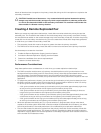
by the name of the virtual disk. You define the secondary virtual disk by name with either the name or the
World Wide Identifier (WWID) of the storage array on which the secondary virtual disk resides. The
primary virtual disk name, the secondary virtual disk name, and the remote storage array name (or WWID)
are the minimum information that you need to provide. Using this command, you can also define
synchronization priority, write order, and write mode.
The command takes this form:
create remoteReplication primary=“primaryVirtualDiskName”
secondary=“secondaryVirtualDiskName”
(remoteStorageArrayName=“storageArrayName” |
remoteStorageArrayWwn=“
wwID”) remotePassword=password
syncPriority=(highest | high | medium | low | lowest)
writeOrder=(preserved | notPreserved)
writeMode=(synchronous | asynchronous)
NOTE: You can use the optional parameters as needed to help define your configuration.
This example shows the create remoteReplication command:
c:\...\smX\client>smcli 123.45.67.88 123.45.67.89
-c “create remoteReplication primary=
\”Jan_04_Account\”
secondary=\”Jan_04_Account_B\”
remoteStorageArrayName=\”Tabor\”
remotePassword=\”jdw2ga05\” syncPriority=highest
writeMode=synchronous;”
The command in this example creates a remote replication in which the primary virtual disk is named
Jan_04_Account on the local storage array. The secondary virtual disk is named Jan_04_Account_B on
the remote storage array that is named Tabor. The names used in this example are similar, but that is not
a requirement for the virtual disk names in a remote replicated pair. In this example, the remote storage
array has a password that you must enter when making any change to the storage array configuration.
Creating a remote replicated pair is a significant change to a storage array configuration.
Setting the write mode to synchronous and the synchronization priority to highest means that host write
requests are written to the primary virtual disk and then immediately copied to the secondary virtual disk.
These actions help to make sure that the data on the secondary virtual disk is as accurate a copy of the
data on the primary virtual disk as possible. The highest synchronization priority does, however, use more
system resources, which can reduce system performance.
This example shows how to use the command in a script file:
create remoteReplication primary=”Jan_04_Account”
secondary=”Jan_04_Account_B” remoteStorageArrayName=”Tabor”
remotePassword=”jdw2ga05” syncPriority=highest
writeMode=synchronous;
After you have created a remote replication, you can see the progress of data synchronization between
the primary virtual disk and the secondary virtual disk by running the show remoteReplication
synchronizationProgress
command. This command shows the progress as a percentage of data
synchronization that has completed.
Changing Remote Replication (Legacy) Settings
The set remoteReplication command lets you change the property settings for a remote replicated
pair. Use this command to change these property settings:
• The virtual disk role (either primary or secondary)
105


















